Les Talens Lyriques, Christophe Rousset
109:01 (2 CDs)
Aparté AP197
Although first published in 1726, Les Nations largely consists of music conceived some years earlier. An example of François Couperin’s pre-occupation with les goûts reunis (the combination of French and Italian styles), it contains four instrumental works that each open with a trio sonata in the Corellian style before continuing with a sequence of dances familiar from the French suite. Couperin provided a charming explanation of how his motivation stemmed from the works of Corelli and Lully, ‘both of whose compositions I shall love as long as I live’. Amusingly, he goes on to explain how knowing that the French are averse to foreign innovation he passed off the first of the sonatas (which he termed ‘sonades’) as being the work of an obscure Italian composer, in fact an anagram of his name. It was, Couperin relates, greeted with such acclaim that he felt encouraged to go on and write the remaining sonatas. Although three of the works are named after nations – France, Spain and Piedmont – there are no specific national characteristics other than the stylistic elements mentioned.
The score makes no indication as to the instrumentation of Les Nations, but it is usual for strings to be employed, as, for example, in the fine recording by the Purcell Quartet (Chandos) involving just five performers. By contrast, Christophe Rousset gives us a sumptuous version with no fewer than ten players, including pairs of violins, flutes, oboes, bassoon, viola da gamba and theorbo, directed by Rousset from the harpsichord. In the wrong hands such a venture might have become a vulgar exhibition of brash daubing of instrumental colours, but so sensitive to the music is Rousset, so deftly handled and musical are the alternations that the results are utterly enchanting. Obviously types of movement suggest a particular instrumentation: slower movements such as those marked ‘gravement’ in the sonatas or dances such as the sarabandes, obviously work better with cool, sensually drooping flutes or expressive violins, while ‘vivement’ movements are well suited to the classic trio combination of piquant oboes and bassoon. To a considerable extent Rousset’s choice conforms to expectations, but it is by no means hidebound and occasionally springs a surprise, as in the noble Allemande of the Suite in the 4me Ordre, ‘La Piemontaise’, which is given to the wind trio. In some bigger movements like chaconnes or passacailles, Rousset parades a riot of colour and texture where the constant tossing of material from one instrumental group to another resembles nothing so much as jazz riffs. The results are exhilarating, spontaneous-sounding music making.
One or two memorable individual moments. The Allemande that opens the suite of ‘La Française’ (1er Ordre) features elegant interweaving between flute and violin, the balance between instruments (which is exceptional throughout) and rhythmic flow perfectly caught in playing that somehow distils the very essence of French Baroque music into this one movement. Later there is a Sarabande in which the two flutes caress in a kind of idealized reverie. The 2me Ordre (‘L’Espagnole’) finds the Allemande allotted to oboe/bassoon trio, where the wonderful modulation to the minor in the second half is handled with loving care. The Sonata of the 3me Ordre (‘L’Impériale’) was composed later than much of the music of Les Nations and is remarkable throughout. The most Corellian of all the sonatas, it opens with the violins weaving imitative sequential chains of gracious nobility, before proceeding to a brief Vivement given to the oboe/bassoon trio, a contrapuntal dotted Gravement for strings, a gently undulating Légèrement for the flutes, another quick section for the wind trio and a complex concluding fugal movement for the strings.
Finally a few words on the sound, which is exceptional by any standard That is doubtless in large part as a result of the recording having been made in the extraordinary acoustic of the magnificently lavish Galerie dorée of the Banque de France, once the home of the comte de Toulouse. I note too that the Banque was one of the sponsors of the recording. I wonder when the Bank of England last sponsored a recording of, say, Purcell? Mid-summer is rather early to start talking of best recordings of the year, but something remarkable is going to have to happen if this delectable issue is not right in the forefront of claimants.
Brian Robins
